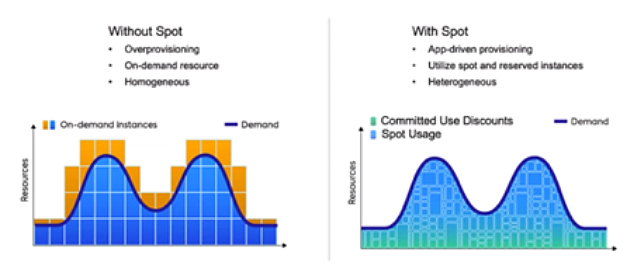Enterprise Architect
Spot by NetApp – Leverage the Most Efficient Economics for Cloud Applications
Spot was founded by Amiram Shachar based on a graduate student project he designed to save companies significant amounts of money on their cloud computing costs while maintaining availability and business continuity using automation. While Shachar never did finish his graduate degree, he grew the company to be the leading cloud compute management and cost optimization solution for public cloud services users, selling Spot to NetApp in early 2020 for $450 million.
What made Spot so valuable? Its product portfolio helps customers with Day 2 cloud operations (CloudOps), giving them the capability to leverage the most efficient economics for their high-performance applications. Spot also follows a licensing model that is based around how much money the products save customers on cloud compute cost, which is, on average, 50% to 70%. NetApp clearly saw the opportunity for Spot to disrupt the marketplace and we’re excited to offer it as part of our portfolio at Mainline. Spot supports the major public cloud service providers, including Amazon Web Services (AWS), Microsoft Azure, and Google Cloud.
NetApp is continually upgrading Spot to increase its value to users. Many of the products in the Spot suite have been updated to increase their capabilities. Spot is also adding a new product, Wave.
Where Does Spot by NetApp Fit?
Spot by NetApp is a product suite that extends the concepts of Continuous Integration and Continuous Deployment to Continuous Optimization.

– Analyze consists of ongoing monitoring of an application, a set of virtual machines (VMs), or storage in order to understand usage patterns, how it scales, and determine what types of cost optimization can be used.
– Optimize allows companies to dynamically adjust cloud infrastructure based on ongoing, real-time analysis. This includes procuring or selling capacity as well as changing instance types.
– Scale enables companies to right-size and cost optimize their capacity to deliver at scale.
Adding continuous optimization to the mix does away with the need for manual tweaks, ensuring that once an application gets deployed to the cloud, the cost model and the infrastructure are optimized and right-sized for it every second the application is running. This frees up developers and engineers to work on functionality and business requirements.
Spot works with all the major public cloud services (AWS, Microsoft Azure, Google Cloud), constantly monitoring what types of cost optimization and market options are available. It helps with scaling of big data workloads by understanding where the application load will be in the future.
Cloud Purchasing Models
To understand the value Spot can bring to an organization, it is important to understand the major public cloud services purchasing models.
- On Demand is often where organizations start. It allows you to scale cloud environments up and down for variable demand. While it is the most expensive per-unit cost over time, it requires no commitment.
- Reserved Capacity is more affordable per unit but requires a commitment for future use.
- Excess capacity, spot instances are the cheapest option, offering up to a 90% discount from On Demand pricing, but this is also the riskiest option. There is no SLA, and the compute capacity can be taken away at any moment.
The goal of Spot is to never pay on-demand pricing again. Using a powerful portfolio of products, Spot dynamically adjusts cloud infrastructure to the most cost-optimized method for an application and intelligently uses opportunities like reserved capacity and spot instances to save money.

Spot by NetApp Portfolio
Cloud Analyzer is a cloud infrastructure management solution that uses advanced analytics to provide visibility and insights into your cloud costs, shows you where you can optimize those costs, and lets you implement that optimization using Spot’s portfolio of continuous optimization products in just a few clicks. Cloud Analyzer provides efficiency scores, which can direct you to better pricing models, especially using spot instance pricing with autoscaling applications.
Elastigroup (VM) is the original product of Spot and provides the ability to blend Reserved Instances (RI), OnDemand and Spot instances, as well as to predict the Spot market. It is an enhancement for auto-scaling based on a market prediction model. It can analyze congestion in spot instance markets and intelligently spin up on-demand capacity instances to ensure the application can continue to work without interruption. It can then move the workload back to spot instance capacity when the congestion clears.
For Elastigroup, NetApp recently released:
Predictive rebalancing: Updated algorithms help to predict how Spot markets are going to work in the future. This capability allows customers to start defining time periods and lengths to run applications in the cloud and to run the application at the best cost model. This capability is automatically enabled in Elastigroup.
Upcoming Releases include:
1.) Intelligent Traffic Flow, which analyzes traffic on the load balancers and CPU on the infrastructure behind it. There is no need to set the instance type on the VM. Elastigroup will set the correct CPU settings based on metrics. Spot is looking for customers that want to test this function before it is made generally available.
2.) Stateful Elastigroup for Azure, which keeps networking/IP Information/data so users are able to define maintenance windows for applications. This is already available for AWS today.
3.) Predictive Autoscaling, which, on the heels of predictive rebalancing, learns the application and predicts when an autoscaling event needs to occur, prior to the application feeling the pain. The compute is there when the application needs it, so there is no latency from waiting for VMs to spin up.
Ocean (Containers) Works on three different levels:
1.) Infrastructure – Spot can use the diversity of compute and pricing models to run Kubernetes in the most cost-optimized way.
2.) Pod Autoscaling Ability – Spot can auto provision and right-size to meet cloud data demands
3.) Kubernetes Pods – Ocean looks at the Kubernetes pods themselves, optimizing CPU and Memory.
Recent releases include:
1.) Support for GKE shielded nodes and protected VMs. The controller will auto detect shielded nodes and manage the nodes appropriately.
2.) New version of Ocean for AKS (Azure Kubernetes) provides native support for AKS with the same look and feel for EKS, GKE and AKS.
3.) Support for Azure Spot VMs and Ocean Virtual Node Groups
Upcoming Releases include:
1.) Virtual nodes group expansion, removing the need to manage node pools and auto scale groups.
2.) Ocean Insights installs the controller in read-only mode and allows Spot to discover how to run a cluster more efficiently without having to auto scale. It looks at things such as the distribution of pods.
3.) Azure CNI Support enables the use of any network option in Azure as the underlying network for an Ocean AKS Cluster.
4.) Automatic right-sizing will now be conducted at the Pod level instead of the infrastructure layer as it is today. When Pods and Containers are optimized, it will also ensure infrastructure is optimized. The long-term goal is to not have to get memory and CPU requirements for an application but instead get Ocean to figure it out.
5.) Storage Visibility starts with AWS EFS, providing namespace, pod, label, full showback and chargeback information for Pods in the cluster.
6.) Ocean networking enhances connectivity by placing applications that need to talk to each other all the time, near each other. Ocean networking will understand the full communication pattern of the cluster and optimize the network.
Eco is the fastest-growing product. The goal is to seize the biggest cloud discounts with the smallest commitment. Eco will convert/buy/sell any RI you need. If a customer does a lift and shift and makes too big of a commitment, Eco will sell it. Today, Eco is only available for AWS.
However, new releases include:
1.) Eco for Azure with the ability to buy and convert Azure commitments for any subscription.
2.) AWS Flex Accounts (Private Preview) in which Eco will attach AWS Savings Plans to your account when needed and detach them when you don’t, so they are now as flexible as RIs.
3.) ECO for MSPs & Enterprises, which will chargeback/showback/carve out cloud costs for each organization. It provides a detailed set of billing rules for fine-grained chargeback.
Spot Storage is a new addition to the Spot platform, with the combination of NetApp’s Cloud Volumes technology. This is a fully managed block or file storage service that includes snapshots, backups, restores, intelligent tiering, and everything else from the NetApp platform. This allows for one “managed by Spot” architecture for compute and storage in the cloud. The application defines what kind of storage it needs, and Spot will take care of the rest.
Wave is the newest product in private preview. It optimizes a serverless infrastructure for Spark workloads using the Ocean (Kubernetes) capabilities. Spot purchased Data Mechanics and will integrate with Wave to create one product. This product will bring Spark observability and autotuning, integrations with Jupyter Notebooks and Airflow, as well as Data Governance support. Wave will also support on the cloud solutions from all three cloud providers. The goal is to provide the “easy button” for spark application and for the infrastructure to get better and better every time the application runs.
With Spot by NetApp, you can enjoy the best of both worlds — cost savings and availability.
More Information:
As a NetApp Star partner, Mainline delivers enterprise storage solutions that are efficient, reliable, and cost-effective. Our top-level partnership assures clients that we maintain the stringent Star partner certification requirements across the NetApp storage family of products, plus we are backed by a strong relationship with the NetApp team. For more information on how we can help you, contact your Mainline Account Representative directly, or reach out to us here with any questions.

